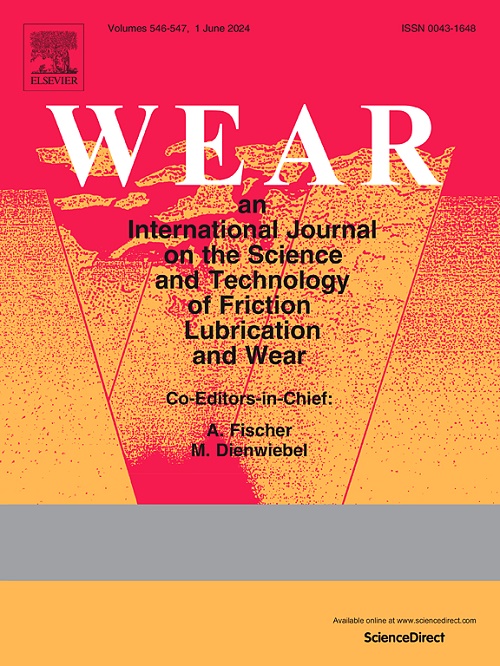200℃及不同载荷条件下等离子转移弧焊Ni-WC涂层摩擦产物演变及磨损机理
IF 6.1
1区 工程技术
Q1 ENGINEERING, MECHANICAL
引用次数: 0
摘要
通过等离子体转移电弧焊制备了 Ni-WC 涂层。根据夹辊的应用情况,研究了涂层在 200 ℃ 下与 H13 钢在不同摩擦载荷下的摩擦产物演变和磨损机理。结果表明,当摩擦载荷为 10-40 N 时,主要的摩擦产物是 H13 钢上产生的氧化铁,氧化物被转移到涂层的摩擦表面。当载荷为 30 N 时,由于材料转移严重,涂层的磨损率达到最大值 13.73 × 10-5 mm3/(N-m)。但当载荷为 40 N 时,压实氧化层的形成阻碍了应力集中层的形成,降低了磨损。当载荷为 50 N 时,形成了连续的铁碳氧化物粘附层,进一步抑制了氧化物的形成和材料的转移,从而将磨损率降低到 1.79 × 10-5 mm3/(N-m)。当摩擦载荷从 10-20 N 增加到 30 N、40 N 和 50 N 时,磨损机制依次从磨料磨损转变为氧化磨损、磨料磨损、氧化磨损和粘合磨损。本文章由计算机程序翻译,如有差异,请以英文原文为准。
Evolution of friction products and wear mechanism of plasma transfer arc welding Ni-WC coating at 200 °C and different load conditions
Ni-WC coating was prepared by plasma transfer arc welding. According to the application scenario of the pinch roll, the evolution of the friction products and wear mechanism of the coating when countering against the H13 steel under different friction loads at 200 °C was investigated. The results showed that at a friction load of 10–40 N, the main friction product was iron oxide generated on the H13 steel, and the oxides were transferred to the friction surface of the coating. When the load was 30 N, due to severe material transfer, the wear rate of the coating reached a maximum value of 13.73 × 10−5 mm3/(N·m). But when the load was 40 N, the formation of compacted oxide layer hindered the formation of stress concentration layer and reduced wear. When the load was 50 N, a continuous adhesive layer of iron-carbon oxide was formed, which further suppressed the formation of oxides and material transfer, thereby reducing the wear rate to 1.79 × 10−5 mm3/(N·m). When the friction load increased from 10-20 N–30 N, 40 N, and 50 N, the wear mechanism shifted from abrasive wear to oxidative and abrasive wear, oxidative wear, and adhesive wear in sequence.
求助全文
通过发布文献求助,成功后即可免费获取论文全文。
去求助
来源期刊

Wear
工程技术-材料科学:综合
CiteScore
8.80
自引率
8.00%
发文量
280
审稿时长
47 days
期刊介绍:
Wear journal is dedicated to the advancement of basic and applied knowledge concerning the nature of wear of materials. Broadly, topics of interest range from development of fundamental understanding of the mechanisms of wear to innovative solutions to practical engineering problems. Authors of experimental studies are expected to comment on the repeatability of the data, and whenever possible, conduct multiple measurements under similar testing conditions. Further, Wear embraces the highest standards of professional ethics, and the detection of matching content, either in written or graphical form, from other publications by the current authors or by others, may result in rejection.
 求助内容:
求助内容: 应助结果提醒方式:
应助结果提醒方式:


